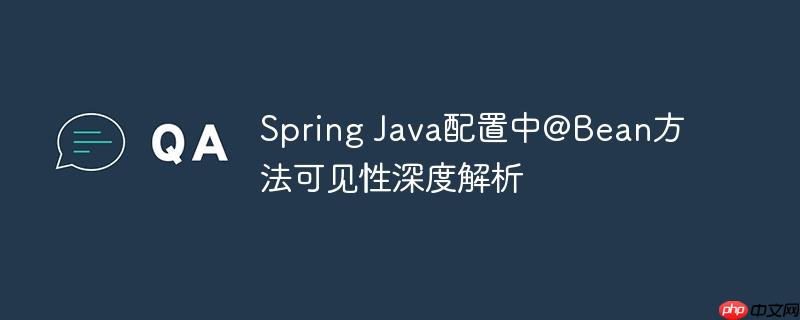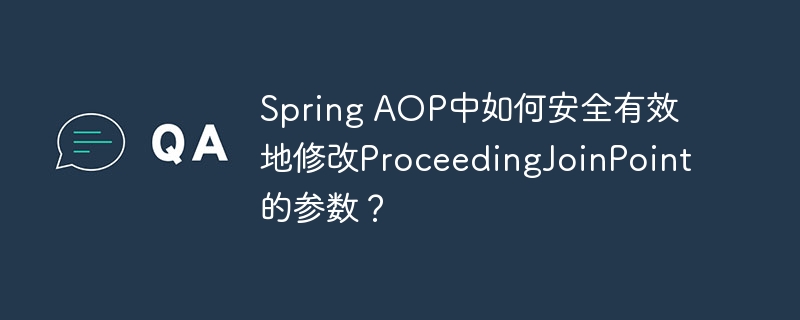
本文深入探讨了spring框架中,当仅使用Java配置时,@Bean注解方法不同可见性修饰符(如public、protected、private)对其行为的影响。重点分析了Spring的CGLIB代理机制如何与方法可见性交互,以及为什么public是推荐的实践,以确保正确的单例行为和依赖管理。
@Bean方法与spring容器
在Spring的Java配置中,@Bean注解方法是定义和声明Spring管理Bean的核心机制。这些方法通常位于使用@Configuration注解的类中,它们负责创建并返回一个将由Spring容器管理的实例。例如:
@Configuration class AppConfig { @Bean public MyComponent myComponent() { return new MyComponent(); } @Bean public AnotherComponent anotherComponent(MyComponent myComponent) { return new AnotherComponent(myComponent); } }
这里,myComponent()和anotherComponent()方法都声明了Spring Bean。Spring容器在启动时会扫描这些@Configuration类,并根据@Bean方法的定义来实例化和管理相应的Bean。
Spring的代理机制与@Configuration
理解@Bean方法可见性的关键在于理解Spring如何处理@Configuration类。当一个类被@Configuration注解时,Spring通常会使用CGLIB(Code Generation Library)为其生成一个运行时子类代理。这个代理类的作用是拦截对@Bean方法的调用,以确保Spring容器的正确行为,特别是对于单例Bean。
例如,如果在一个@Configuration类中,一个@Bean方法内部调用了另一个@Bean方法,Spring的代理机制会拦截这个内部调用,并返回容器中已经存在的单例Bean实例,而不是每次调用都创建一个新的实例。这种行为对于维护Bean的生命周期和依赖关系至关重要。
立即学习“Java免费学习笔记(深入)”;
可见性修饰符对@Bean方法的影响
不同的可见性修饰符(public、protected、package-private、private)对@Bean方法的行为有不同的影响,这主要体现在Spring的代理机制能否有效拦截和管理这些方法。
1. public (公共)
public是@Bean方法最常用且推荐的可见性修饰符。
- 优点:
- 完全可访问性: Spring容器可以轻松发现并调用public方法来创建Bean。
- CGLIB代理兼容性: CGLIB生成的子类代理可以毫无障碍地覆盖public方法,从而确保Spring能够拦截内部的@Bean方法调用,并返回单例实例。
- 清晰性: 明确表示该方法是为Spring容器暴露Bean而设计的。
2. protected (受保护) 和 package-private (包私有)
protected和package-private方法在某些情况下也可以作为@Bean方法使用。
- 行为: Spring的CGLIB代理子类可以访问并覆盖其父类(即@Configuration类)中的protected和package-private方法(如果代理类与原@Configuration类在同一个包中)。这意味着Spring的代理机制通常能够正常工作,拦截内部调用并管理Bean的单例行为。
- 注意事项: 尽管它们可能有效,但不如public直观,可能会降低代码的可读性和可维护性,尤其是在团队协作或代码审查时。
3. private (私有)
private是强烈不推荐用于@Bean方法的可见性修饰符。
- 问题:
- CGLIB代理限制: CGLIB无法覆盖private方法。这意味着Spring生成的代理类无法拦截对这些private @Bean方法的内部调用。
- 破坏单例行为: 如果一个private @Bean方法被同一个@Configuration类中的另一个@Bean方法调用,每次调用都会直接执行该private方法,从而创建新的Bean实例,而不是从Spring容器中获取已存在的单例实例。这违背了Spring容器管理Bean单例的初衷。
- Spring发现问题: 虽然Spring可能通过反射找到private方法来创建Bean,但其核心的代理机制将无法正常工作,导致上述单例问题。
示例:内部Bean依赖与可见性
考虑以下场景,一个@Bean方法依赖于同一个@Configuration类中定义的另一个@Bean:
@Configuration class ServiceConfig { // 推荐:public 方法,确保单例行为 @Bean public DataSource dataSource() { System.out.println("Creating new DataSource (public)"); return new DataSource(); // 假设DataSource是一个简单的类 } @Bean public UserService userService() { System.out.println("Creating new UserService"); // Spring会拦截dataSource()的调用,返回单例的DataSource return new UserService(dataSource()); } // 不推荐:private 方法,可能破坏单例行为 @Bean private AnotherComponent anotherComponentPrivate() { System.out.println("Creating new AnotherComponent (private)"); return new AnotherComponent(); } @Bean public ReportingService reportingService() { System.out.println("Creating new ReportingService"); // 警告:如果anotherComponentPrivate()是private,每次调用都会创建新的实例 // 因为CGLIB无法代理private方法,Spring无法拦截此调用 return new ReportingService(anotherComponentPrivate()); } } // 假设的依赖类 class DataSource {} class UserService { public UserService(DataSource dataSource) {} } class AnotherComponent {} class ReportingService { public ReportingService(AnotherComponent component) {} }
在上面的例子中:
- 当userService()方法调用dataSource()时,由于dataSource()是public的,Spring的代理机制会拦截该调用,并确保userService获得的是Spring容器中唯一的DataSource单例。
- 然而,当reportingService()方法调用anotherComponentPrivate()时,由于anotherComponentPrivate()是private的,Spring的代理机制无法拦截。因此,每次调用anotherComponentPrivate()都会创建一个新的AnotherComponent实例,而不是重用容器中的单例。
总结与最佳实践
在Spring的Java配置中,当仅使用Java配置时:
- 始终推荐使用 public 可见性修饰符来定义 @Bean 方法。 这是最清晰、最可靠的做法,能够确保Spring的代理机制正常工作,从而正确管理Bean的生命周期,特别是单例行为和内部Bean依赖。
- protected 和 package-private 方法在技术上可能可行,因为CGLIB代理通常可以访问它们。但为了代码的清晰性和一致性,public 仍然是首选。
- 绝对避免使用 private 可见性修饰符定义 @Bean 方法。 这将导致Spring的代理机制失效,从而破坏Bean的单例行为,并在内部调用时创建新的实例,这通常不是期望的行为。
遵循这些指导原则,可以确保您的Spring Java配置健壮、可预测且易于维护。


















